Impacts of Soil Moisture on Typical Frontal Rainstorm in Yangtze River Basin
Abstract
:1. Introduction
2. Simulation Description
2.1. Model and Data
2.2. Brief Description of Frontal Rainstorm and Land Surface Conditions
3. Model Evaluation
3.1. Comparison with Observation of Vertical Thermodynamic Profiles
3.2. Comparison of MCSs’ Patterns and Intensity with the Observed TBB and Precipitation
3.3. Comparison of Total Precipitation and Precipitation Rate with Observation
4. Sensitivity of the Rainstorm to Soil Moisture
4.1. Sensitivity of Near-Surface and Upper PBL Characteristics to Soil Moisture
4.2. The Possible Relations between Land Surface and Upper MCSs
4.3. Sensitivity of Precipitation to Soil Moisture
5. Conclusions and Discussion
Acknowledgments
Author Contributions
Conflicts of Interest
References
- Beljaars, A.C.M.; Viterbo, P.; Miller, M.J.; Betts, A.K. The anomalous rainfall over the United States during July 1993: Sensitivity to land surface parameterization and SM anomalies. Mon. Weather Rev. 1996, 124, 362–383. [Google Scholar] [CrossRef]
- Betts, A.K.; Ball, J.H.; Beljaars, A.C.M.; Miller, M.J.; Viterbo, P.A. The land surface-atmosphere interaction: A review based on observational and global perspectives. J. Geophys. Res. 1996, 101, 7209–7225. [Google Scholar] [CrossRef]
- Jeremy, S.P.; Elfatih, A.B. Eltahir, Pathways relating soil moisture conditions to future summer rainfall within a model of the land-atmosphere system. J. Clim. 2000, 14, 1227–1242. [Google Scholar]
- Valipour, M. Critical areas of Iran for agriculture water management according to the annual rainfall. Eur. J. Sci. Res. 2012, 84, 600–608. [Google Scholar]
- Valipour, M. Evaluation of radiation methods to study potential evapotranspiration of 31 provinces. Meteorol. Atmos. Phys. 2015, 127, 289–303. [Google Scholar] [CrossRef]
- Valipour, M. Optimization of neural networks for precipitation analysis in a humid region to detect drought and wet year alarms. Meteorol. Appl. 2016, 23, 91–100. [Google Scholar] [CrossRef]
- Eltahir, E.A.B. A soil moisture-rainfall feedback mechanism: Theory and observations. Water Resour. Res. 1998, 34, 765–776. [Google Scholar] [CrossRef]
- Pielke, R.A. Influence of the spatial distribution of vegetation and soils on the prediction of cumulus convective rain. Rev. Geophys. 2001, 39, 151–177. [Google Scholar] [CrossRef]
- Seneviratne, S.I.; Corti, T.; Davin, E.L.; Hirschi, M.; Jaeger, E.B.; Lehner, I.; Orlowsky, B.; Teuling, A.J. Investigating soil moisture-climate interactions in a changing climate: A review. Earth-Sci. Rev. 2010, 99, 125–161. [Google Scholar] [CrossRef]
- Gallus, W.A., Jr.; Segal, M. Sensitivity of forecasted rainfall in a Texas convective system to soil moisture and convective parameterization. Weather Forecast. 2000, 15, 509–525. [Google Scholar] [CrossRef]
- Wolters, D.; van Heerwaarden, C.C.; Vilà-Guerau de Arellano, J.; Cappelaere, B.; Ramier, D. Effects of soil moisture gradients on the path and the intesity of a West Africa aquall line. Q. J. R. Meteorol. Soc. 2010, 156, 2162–2175. [Google Scholar]
- Valipour, M.; Eslamian, S. Analysis of potential evapotranspiration using 11 modified temperature-based models. Int. J. Hydrol. Sci. Technol. 2014, 4, 192–207. [Google Scholar] [CrossRef]
- Valipour, M. Comparative evaluation of radiation-based methods for estimation of potential evapotranspiration. J. Hydrol. Eng. 2014, 10, 1943–5584. [Google Scholar] [CrossRef]
- Valipour, M. Long-term runoff study using SARIMA and ARIMA models in the United States. Meteorol. Appl. 2015, 22, 592–598. [Google Scholar] [CrossRef]
- Valipour, M. Study of different climatic conditions to assess the role of solar radiation in reference crop evapotranspiration equations. Arch. Agron. Soil Sci. 2015, 61, 679–694. [Google Scholar] [CrossRef]
- Valipour, M. Investigation of Valiantzas’ evapotranspiration equation in Iran. Theor. Appl. Climatol. 2015, 121, 267–278. [Google Scholar] [CrossRef]
- Ek, M.; Mahrt, L. Daytime evolution of relative humidity at the boundary layer top. Mon. Weather Rev. 1994, 122, 2709–2721. [Google Scholar] [CrossRef]
- Ek, M.; Holstag, A.A.M. Influence of soil moisture on boundary layer development. J. Hydrometeorol. 2004, 5, 86–99. [Google Scholar] [CrossRef]
- Chen, F.; Avissar, R. Impact of land surface moisture variability on local shallow convective cumulus and precipitation in large scale models. J. Meteorol. 1994, 33, 1382–1401. [Google Scholar] [CrossRef]
- Findell, K.L.; Eltahir, E.A.B. Atmospheric controls on soil moisture-boundary layer interactions. Part I: Framework development. J. Hydrometeorol. 2003, 4, 552–569. [Google Scholar] [CrossRef]
- Seneviratne, S.; Lüthi, D.; Litschi, M.; Schär, C. Land-atmosphere coupling and climate change in Europe. Nature 2006, 443, 205–209. [Google Scholar] [CrossRef] [PubMed]
- Ronda, R.J.; van den Hurk, B.J.J.M.; Holtslag, A.A.M. Spatial heterogeneity of the soil moisture content and its impact on surface flux densities and near-surface meteorology. J. Hydrometeorol. 2002, 3, 556–570. [Google Scholar] [CrossRef]
- Ookouchi, Y.; Segal, M.; Kessler, R.C.; Pielke, R.A. Evaluation of soil moisture effect on the generation and modification of mesoscale circulation. Mon. Weather Rev. 1984, 112, 2281–2292. [Google Scholar] [CrossRef]
- Segal, M.; Arritt, W.R. Nonclassical mesoscale circulations caused by surface sensible heat-flux gradients. Bull. Am. Meteorol. Soc. 1992, 73, 1593–1604. [Google Scholar] [CrossRef]
- Weaver, C.P. Coupling between Large-Scale Atmospheric Processes and Mesoscale Land–Atmosphere Interactions in the U.S. Southern Great Plains during summer. Part I: Case Studies. J. Hydrometeor. 2005, 5, 1223–1246. [Google Scholar] [CrossRef]
- Baker, R.D.; Lynn, B.H.; Boone, A.; Tao, W.T.; Simpson, J. The influence of soil moisture, coastline curvature, and land-breeze circulation on sea-breeze-initiated precipitation. J. Hydrometeorol. 2001, 2, 193–211. [Google Scholar] [CrossRef]
- Eric, A.S.; Mickey, M.K.W.; Harry, J.C.; Michael, T.R.; Ann, H. Linking boundary-layer circulations and surface processed during FIFE89. Part I: Observational analysis. J. Atmos. Sci. 1994, 51, 1497–1529. [Google Scholar]
- Taylor, C.M.; Ellis, R.J. Satellite detection of soil moisture impacts on convection at the mesoscale. Geophys. Res. Lett. 2006, 34, L03404. [Google Scholar] [CrossRef]
- LeMone Margaret, A.; Chen, F.; Mukul, T.; Tewari, M.; Dudhia, J.; Geerts, B.; Miao, Q.; Coulter, R.L.; Grossman, R.L. Simulating the IHOP_2002 Fair-Weather CBL with the WRF-ARW-Noah modeling system. Part I: Surface fluxes and CBL structure and evolution along the eastern track. Mon. Weather Rev. 2010, 138, 722–744. [Google Scholar] [CrossRef]
- Bianca, A.; Norbert, K.; Leonhard, G. Initiation of deep convection caused by land surface inhomogeneities in West Africa: A modelled case study. Meteorol. Atmos. Phys. 2011, 112, 15–27. [Google Scholar]
- Jones, A.R.; Brunsell, N.A. A scaling analysis of soil moisture-precipitation interactions in a regional climate model. Theor. Appl. Climatol. 2009, 98, 221–235. [Google Scholar] [CrossRef]
- Moira, E.D.; Javier, T.; Daniel, A.R.; Sin, C.C. Experiments using new initial soil moisture conditions and soil map in the Eta model over La Plata basin. Meteorol. Atmos. Phys. 2013, 121, 119–136. [Google Scholar]
- Leonhard, G.; Norbert, K. Sensitivity of a modelled life cycle of a mesoscale convective system to soil conditions over West Africa. Q. J. R. Meteorol. Soc. 2010, 136, 471–482. [Google Scholar]
- Clark, D.B.; Taylor, C.; Thorpe, A.J. Feedback between the land surface and rainfall at convective length scales. J. Hydrometeorol. 2004, 5, 625–639. [Google Scholar] [CrossRef]
- Paul, F.; Linda, S.; Juerg, S.; Wolfgang, L.; Christoph, S. Influence of the background wind on the local soil moisture precipitation feedback. J. Atmos. Sci. 2013, 71, 782–797. [Google Scholar]
- Leeper, R.; Mahmood, R.; Quintanar, A.I. Near-surface atmospheric response to simulated changes in land-cover vegetation fraction, and soil moisture over Western Kentucky. Publ. Clim. 2009, 62, 41. [Google Scholar]
- Leeper, R.; Mahmood, R.; Quintanar, A.I. Influence of karst landscape on planetary boundary layer atmosphere: A Weather Research and Forecasting (WRF) model-based investigation. J. Hydrometeorol. 2011, 12, 1512–1529. [Google Scholar] [CrossRef]
- Quintanar, A.I.; Mahmood, R.; Loughrin, J.; Lovanh, N.C. A coupled MM5-NOAH land surface model-based assessment of sensitivity of planetary boundary layer variables to anomalous soil moisture conditions. Phys. Geogr. 2008, 29, 54–78. [Google Scholar] [CrossRef]
- Hohenegger, C.; Brockhaus, P.; Bretherton, C.S.; Schär, C. The soil moisture-precipitation feedback in simulations with explicit and parameterized convection. J. Clim. 2009, 22, 5003–5020. [Google Scholar] [CrossRef]
- Astrid, S.; Rezaul, M.; Arturo, I.Q.; Adriana, B.P.; Roger, P. A comparison of the MM5 and the regional atmospheric modeling system simulations for land-atmosphere interactions under varying soil moisture. Tellus A 2014, 66, 12486. [Google Scholar]
- Ma, Z.; We, H.; Fu, C. Relationship between regional soil moisture variation and climatic varaiblity over East China. Acta Meteorol. Sin. 2000, 3, 278–287. (In Chinese) [Google Scholar]
- Sun, C.H.; Li, W.; Zhang, Z.; He, J.H. Distribution and variation feature of soil humidity anomaly in HuaiHe River basin and its relationship with climatic anomaly. Chin. Appl. Meteorol. Sci. 2005, 16, 129–138. (In Chinese) [Google Scholar]
- Ding, Y.; Shi, X.; Liu, Y.M.; Liu, Y.; Li, Q.; Qian, Y.F.; Miao, M.; Zhai, G.; Gao, K. Multi-year simulations and experimental seasonal predictions for rainy seasons in China by using a nested regional climate model (RegCM_NCC). Part I: Sensitivity study. Adv. Atmos. Sci. 2006, 23, 324–341. [Google Scholar] [CrossRef]
- Hu, Y.M. A Numerical Simulation Study of abnormal Meiyu in Yangtze-Huaihe Region and the Data Assimilation of Soil Moisture on its Improvement. Ph.D. Phesis, Nanjing University of Information Science and Technology, Nanjing, China, 2006. [Google Scholar]
- Lin, C.; Yang, X.; Guo, Y. Sensitivity of the IAP95 model to the initial condition of soil moisture. Clim. Environ. Res. 2001, 6, 240–248. (In Chinese) [Google Scholar]
- Shi, X. Numerical study of initial soil moisture impacts on regional surface climate. Atmos. Clim. Sci. 2011, 1, 172–185. [Google Scholar] [CrossRef]
- Zhang, J.; Wu, L.; Dong, W. Land-atmosphere coupling and summer climate variability over East Asia. J. Geophys. Res. 2011, 116, D05117. [Google Scholar] [CrossRef]
- Li, Z.; Zhou, T.; Chen, H.; Ni, D.; Zhang, R.H. Modeling the effect of soil moisture variability on summer precipitation variability over East Asia. Int. J. Climatol. 2015, 35, 879–889. [Google Scholar] [CrossRef]
- Douville, H.; Chauvin, F.; Broqua, H. Influence of soil moisture on the Asian and African Monsoons. Part I: Mean monsoon and daily precipitation. J. Clim. 2001, 14, 2381–2403. [Google Scholar] [CrossRef]
- Trier, S.B.; Chen, F.; Manning, K.W.; LeMone, M.A.; Davis, C.A. Sensitivity of the PBL and precipitation in 12-day simulations of warm-season convection using different land surface models and soil wetness conditions. Mon. Weather Rev. 2008, 136, 2321–2343. [Google Scholar] [CrossRef]
- Zhang, W.; Zhou, T.; Yu, R. Spatial distribution and temporal variation of soil moisture over China Part I: multi-data intercomparison. Chin. J. Atmos. Sci. 2008, 32, 581–596. (In Chinese) [Google Scholar]
- Gao, Q.J.; Guan, Z.; Du, N.; Hu, T. Comparison of in situ station data and reanalysis data in winter and summer temperature in China. Proc. SPIE 2008, 7083, 1–12. [Google Scholar]
- Valipour, M. Sprinkle and Trickle irrigation system design using tapered pipes for pressure loss adjusting. J. Agric. Sci. 2012, 4. [Google Scholar] [CrossRef] [Green Version]
- Valipour, M. Comparison of surface irrigation simulation models: Full hydrodynamic, zero inertia, kinematic wave. J. Agricul. Sci. 2012, 4. [Google Scholar] [CrossRef]
- Valipour, M.; Ali, G.S.M.; Eslamian, S. Surface irrigation simulation models: A review. Int. J. Hydrol. Sci. Technol. 2015, 5. [Google Scholar] [CrossRef]
- Valipour, M.; Khasraghia, M.M.; Ali, G.S.M. Simulation of open-and closed-end border irrigation systems using SIRMOD. Arch. Agron. Soil Sci. 2015, 61, 929–941. [Google Scholar]
- Skamarock, W.C.; Klemp, J.B.; Dudhia, J.; Gill, D.O.; Barker, D.M.; Duda, M.; Huang, X.Y.; Wang, W.; Powers, J.G. A Description of the Advanced Research WRF Version 3; Report NCAR/TN-475+STR; National Center for Atmospheric Research: Boulder, CO, USA, 2008. [Google Scholar]
- Chen, F.; Duhia, J. Coupling and advanced land surface hydrology model with the Penn State-NCAR MM5 modeling system part I: Model implementation and sensitivity. Mon. Weather Rev. 2001, 129, 569–585. [Google Scholar] [CrossRef]
- Iacono, M.J.; Delamere, J.S.; Mlawer, E.J.; Shephard, M.W.; Clough, S.A.; Collins, W.D. Radiative forcing by long–lived greenhouse gases: Calculations with the AER radiative transfer models. J. Geophys. Res. 2008, 113, D13103. [Google Scholar] [CrossRef]
- Hong, S.-Y.; Dudhia, J.; Chen, S. A revised approach to ice microphysical processes for the bulk parameterization of clouds and precipitation. Mon. Weather Rev. 2004, 132, 103–120. [Google Scholar] [CrossRef]
- Kain, J.S. The Kain-Fritsch convective parameterization: An update. J. Appl. Meteorol. 2004, 43, 170–181. [Google Scholar] [CrossRef]
- Beljaars, A.C.M. The parameterization of surface fluxes in large-scale models under free convection. Q. J. R. Meteorol. Soc. 1994, 121, 255–270. [Google Scholar] [CrossRef]
- Hong, S.Y.; Pan, H.L. Nonlocal boundary layer vertical diffusion in a medium-range forecast model. Mon. Weather Rev. 1996, 124, 2322–2339. [Google Scholar] [CrossRef]
- Hu, X.M.; Nielsen-Gammon, J.W.; Zhang, F. Evaluation of three planetary boundary layer schemes in the WRF model. J. Appl. Meteorol. Climatol. 2010, 49, 1831–1844. [Google Scholar] [CrossRef]
- Frequently Asked Questions (FAQ) on NASA Land Data Assimilation System. Available online: http://ldas.gsfc.nasa.gov/faq/#SoilMoist (accessed on 9 March 2016).
- Tao, S.Y. Chinese Heavy Rains; Science Press: Beijing, China, 1990. (In Chinese) [Google Scholar]
- Parada, L.M.; Liang, X. Impacts of spatial resolutions and data quality on soil moisture data assimilation. J. Geophys. Res. 2008, 113, D10101. [Google Scholar] [CrossRef]
- Liu, L.; Zhang, R.H.; Zuo, Z.Y. Intercomparision of spring soil moisture among multiple reanalysis datasets over Eastern China. J. Geophys. Res. Atmos. 2014, 1, 54–64. [Google Scholar] [CrossRef]
- Cheng, S.; Guan, X.; Huang, J.; Ji, F.; Guo, R. Long-term trend and variability of soil moisture over East Asia. J. Geophys. Res. Atmos. 2015, 120, 8658–8670. [Google Scholar] [CrossRef]
- Zhao, Y. Numerical investigation of a localized extremely heavy rainfall event in complex topographic area during midsummer. Atmos. Res. 2012, 113, 22–39. [Google Scholar] [CrossRef]
- Wang, C.-C. On the calculation and correction of equitable threat score for model quantitative precipitation forecasts for small verification areas: The example of Taiwan. Weather Forecast. 2014, 29, 788–798. [Google Scholar] [CrossRef]
- Christoph, S.; Daniel, L.; Urs, B.; Erdmann, H. The soil-precipitation feedback: A process study with a regional climate model. J. Clim. 1998, 12, 722–741. [Google Scholar]
- Sutton, C.; Hamill, T.M.; Warner, T.T. Will perturbing soil moisture improve warm-season ensemble forecasts? A proof of concept. Mon. Weather Rev. 2006, 134, 3174–3189. [Google Scholar] [CrossRef]
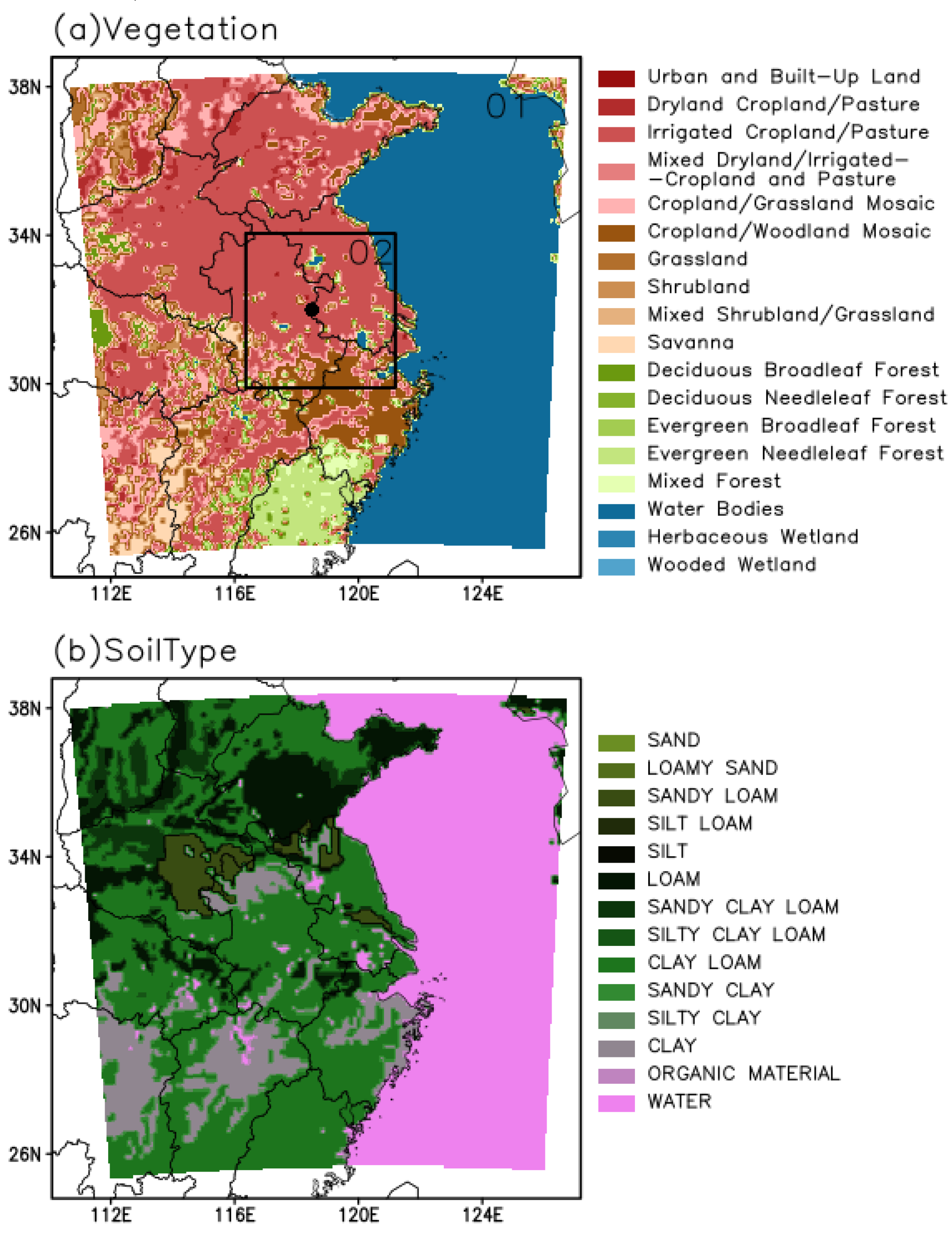
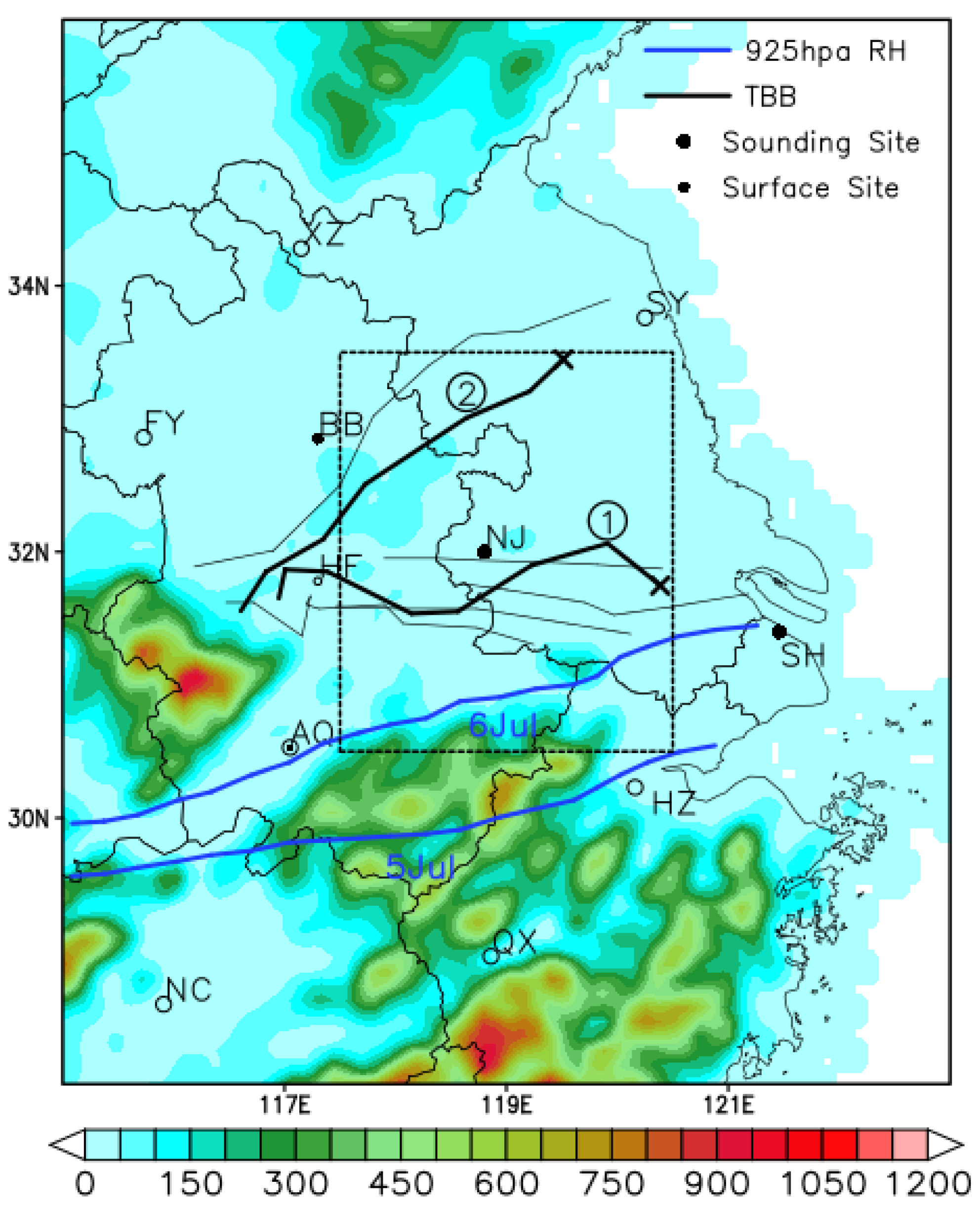
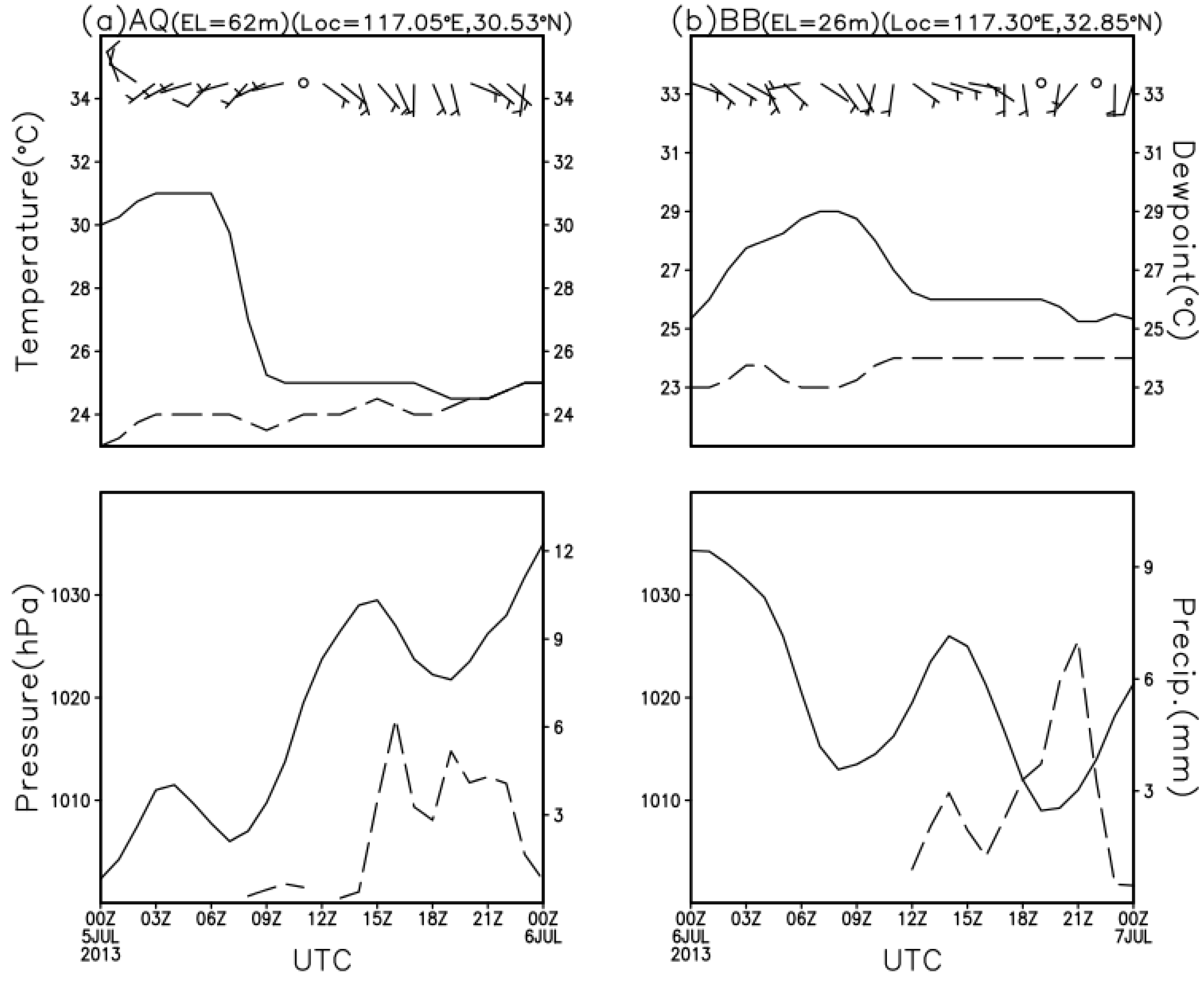
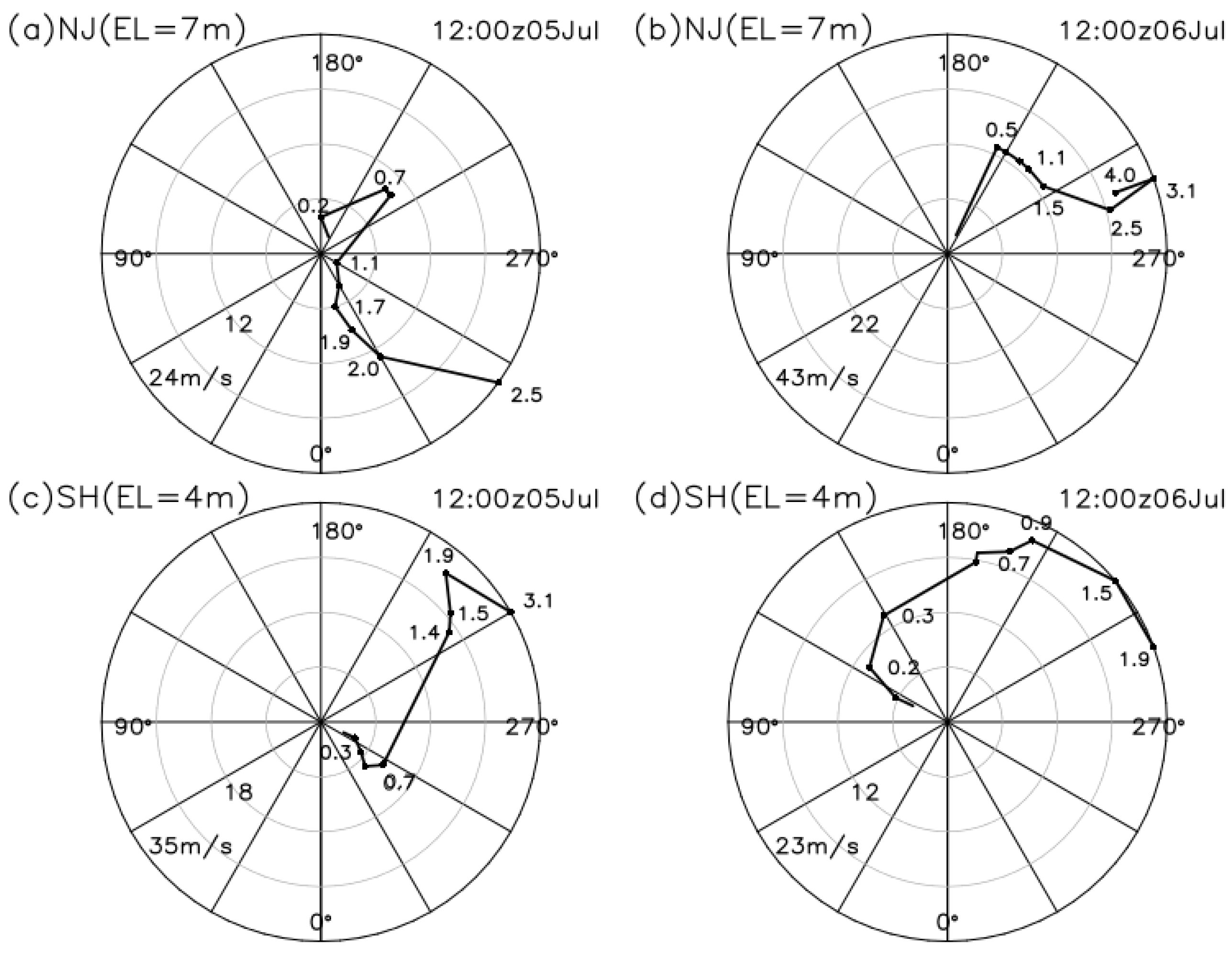
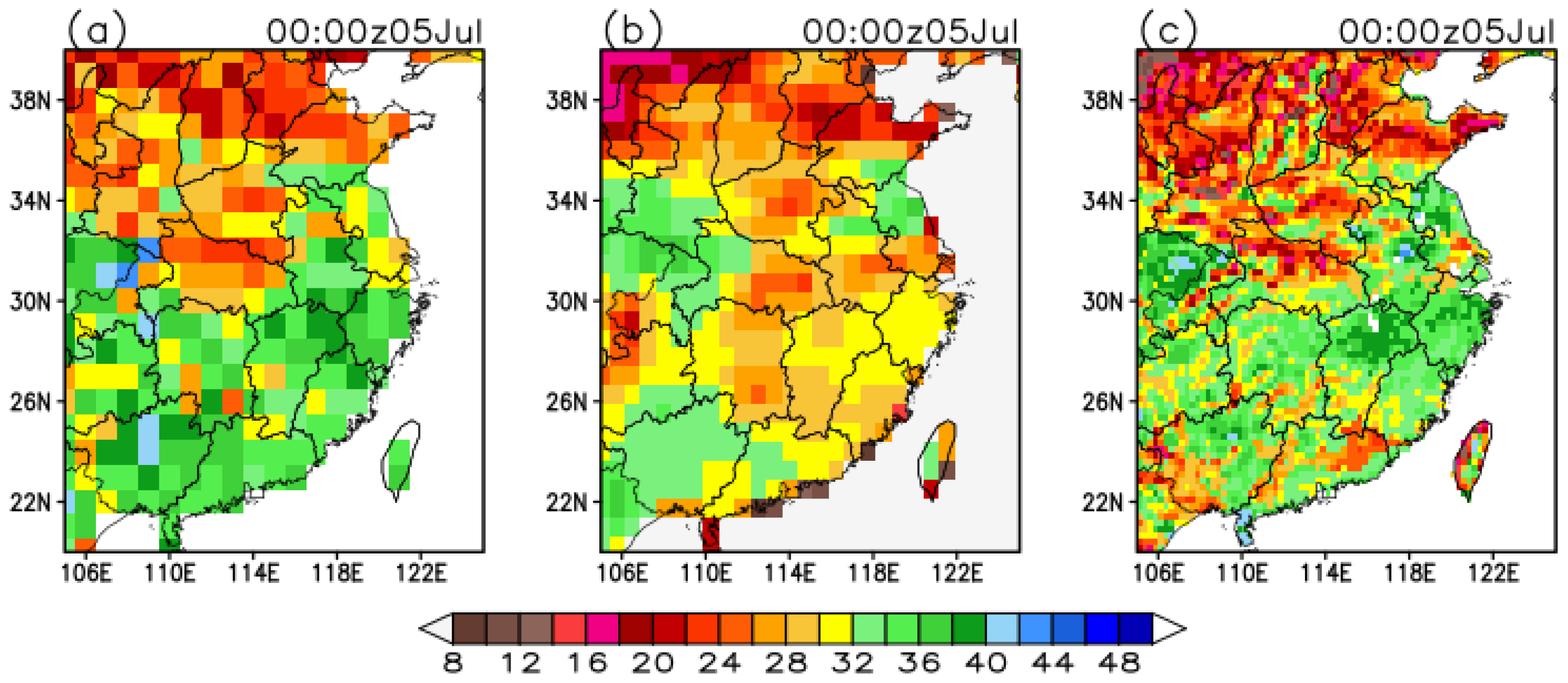
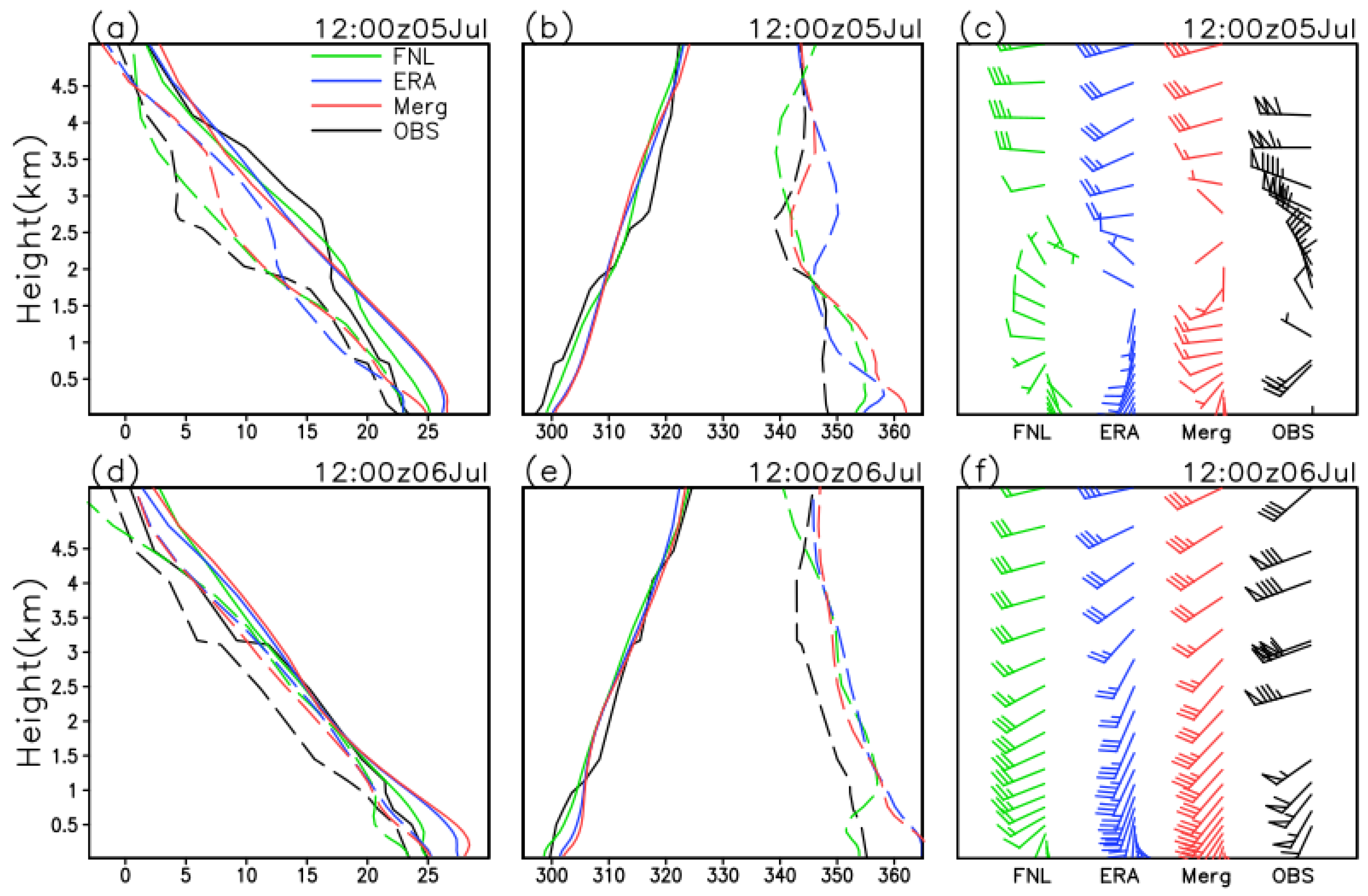
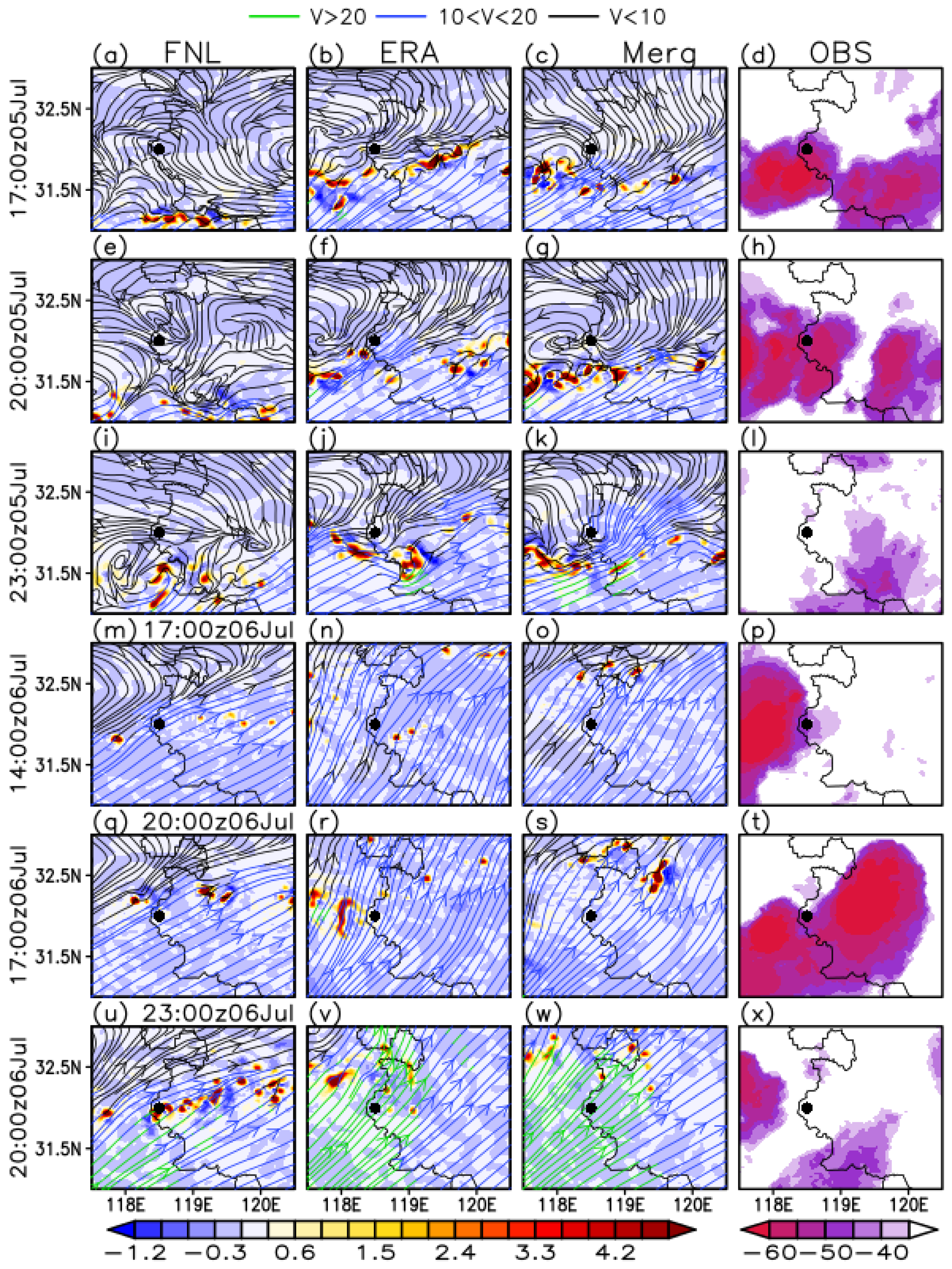
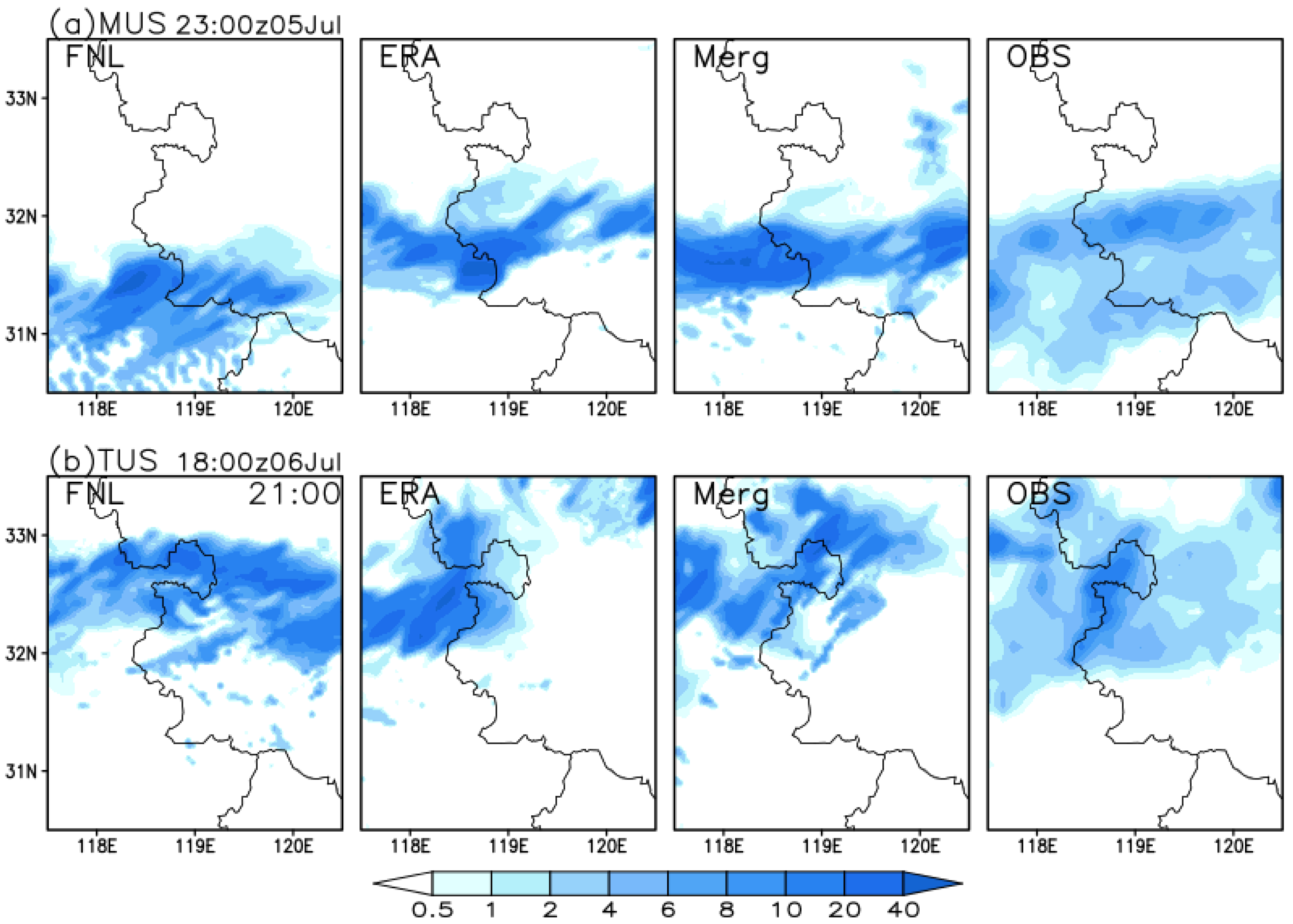
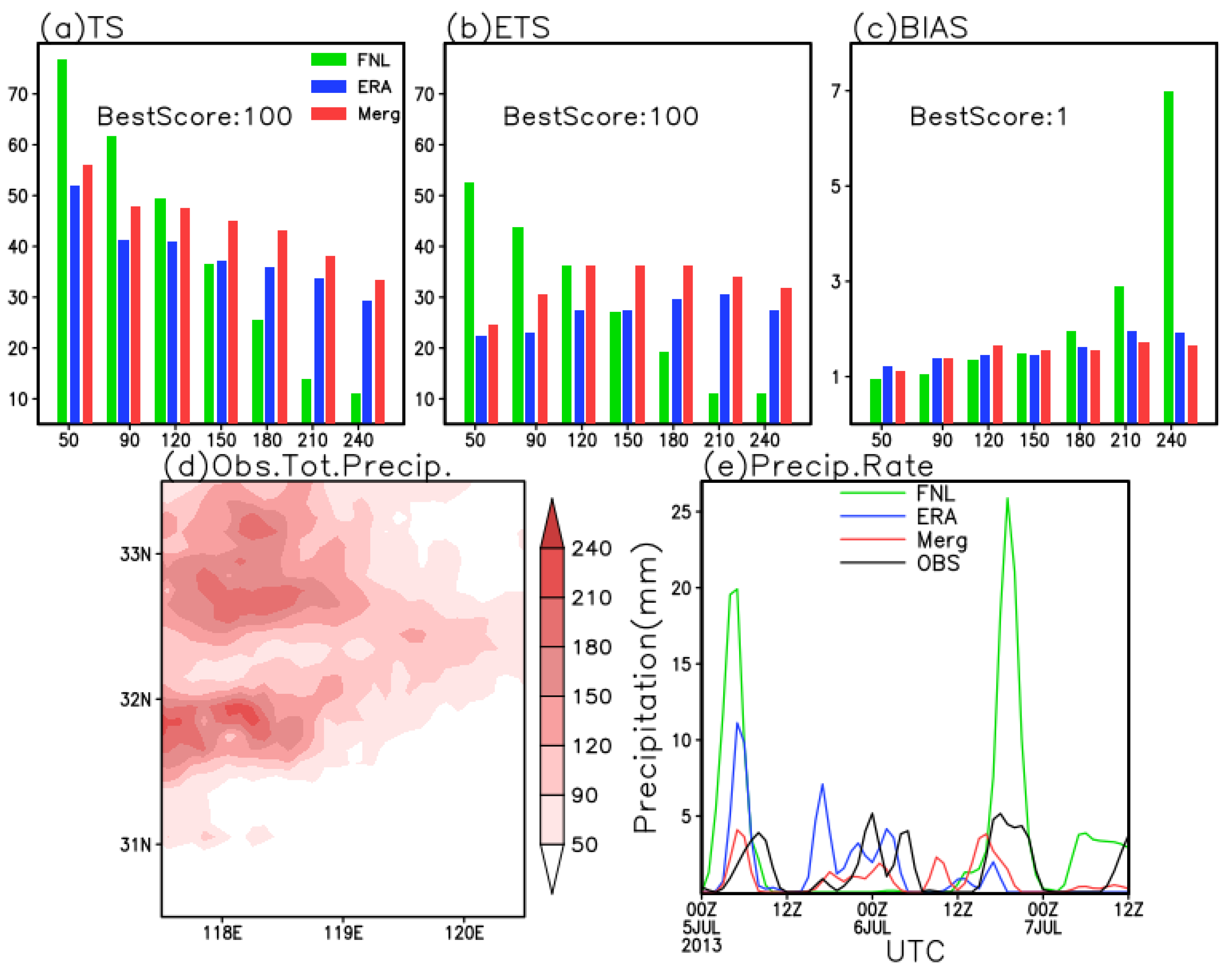
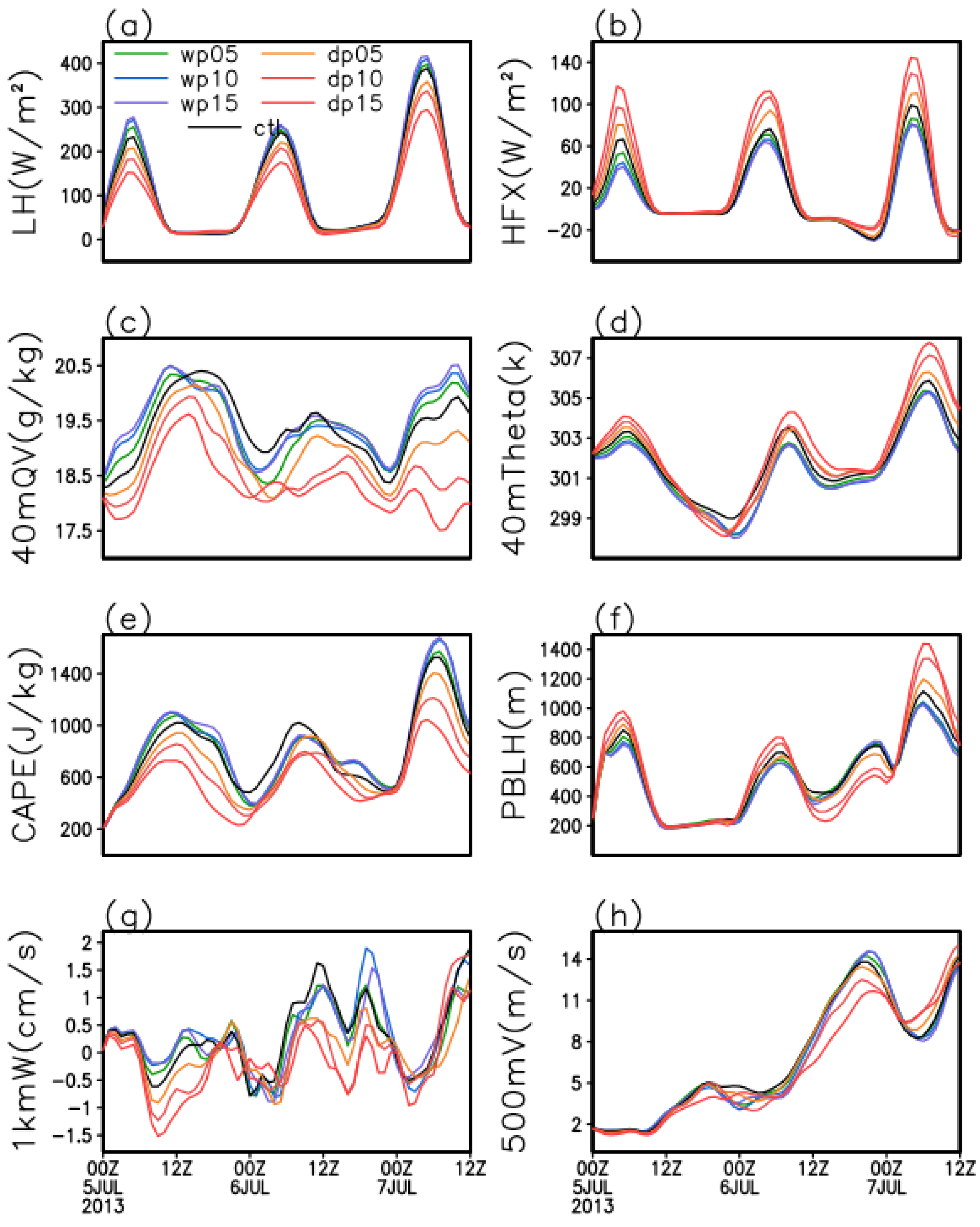
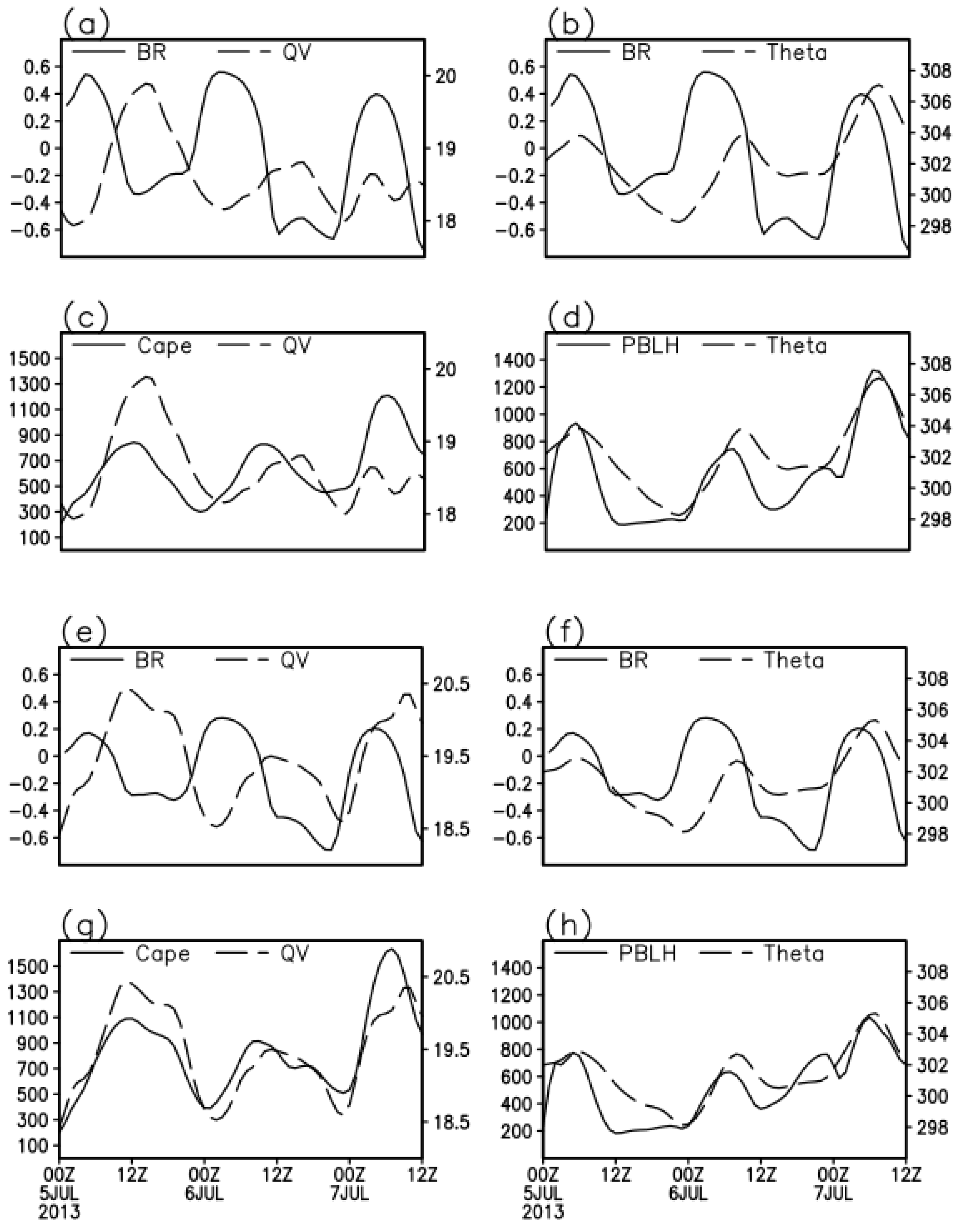
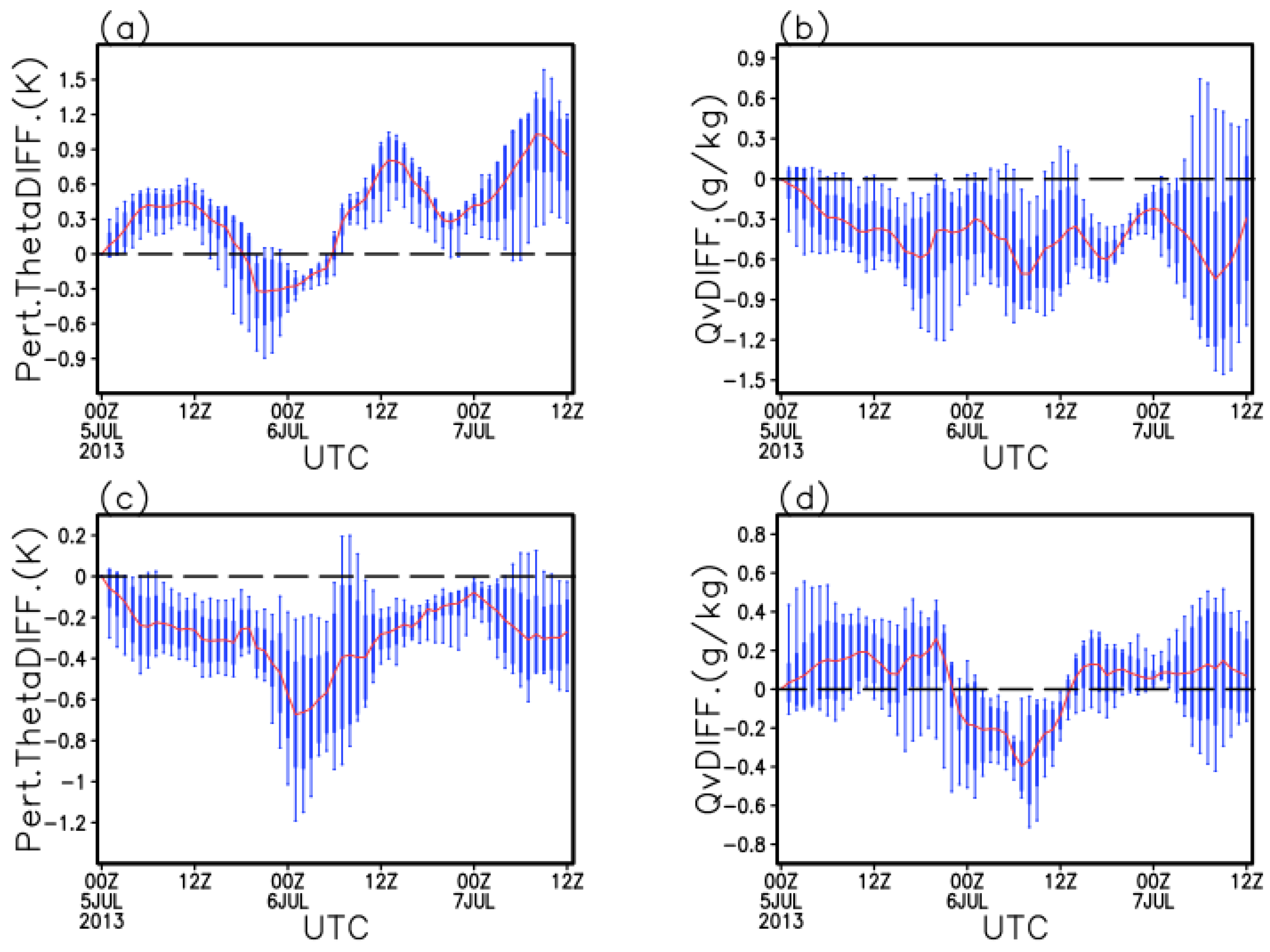
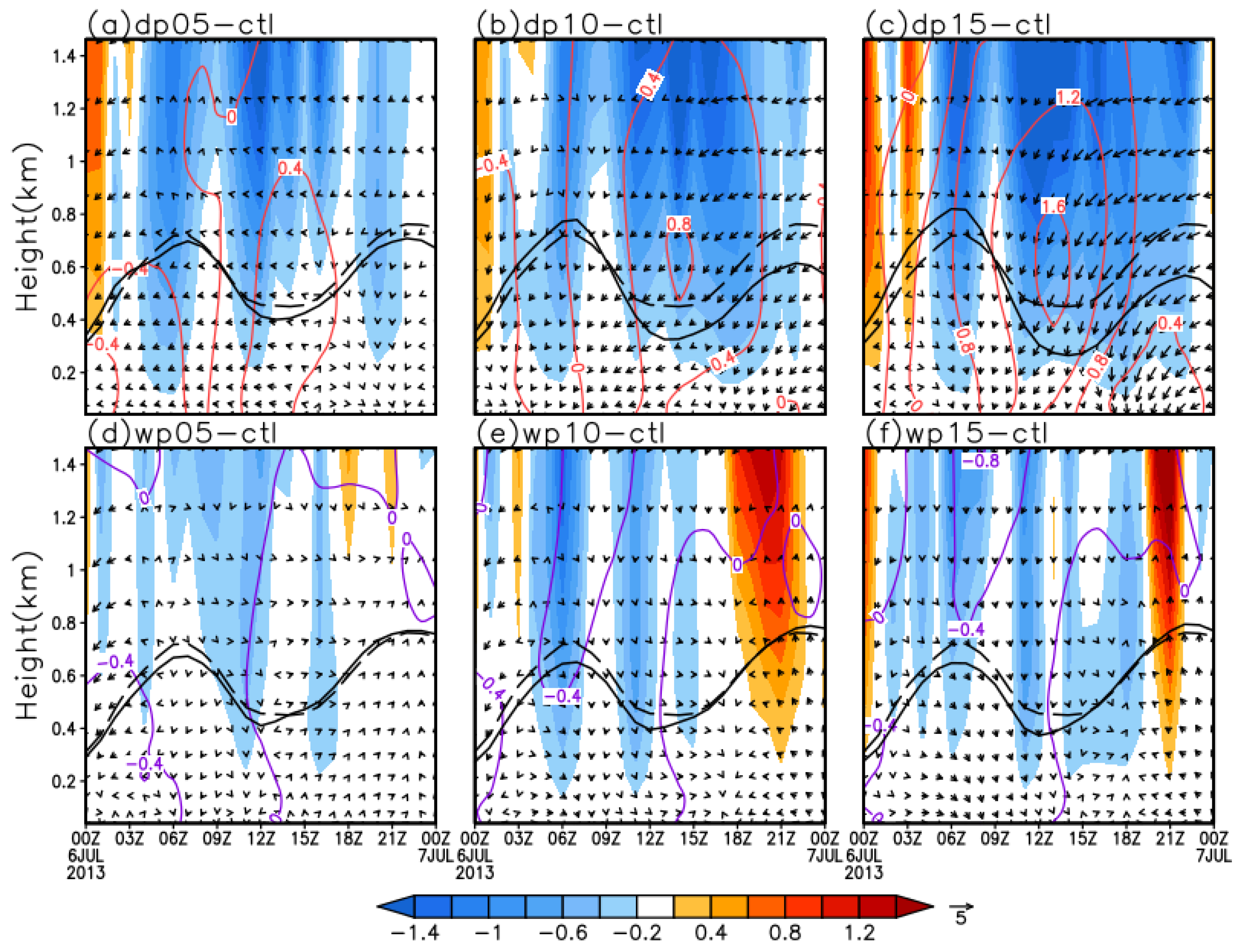
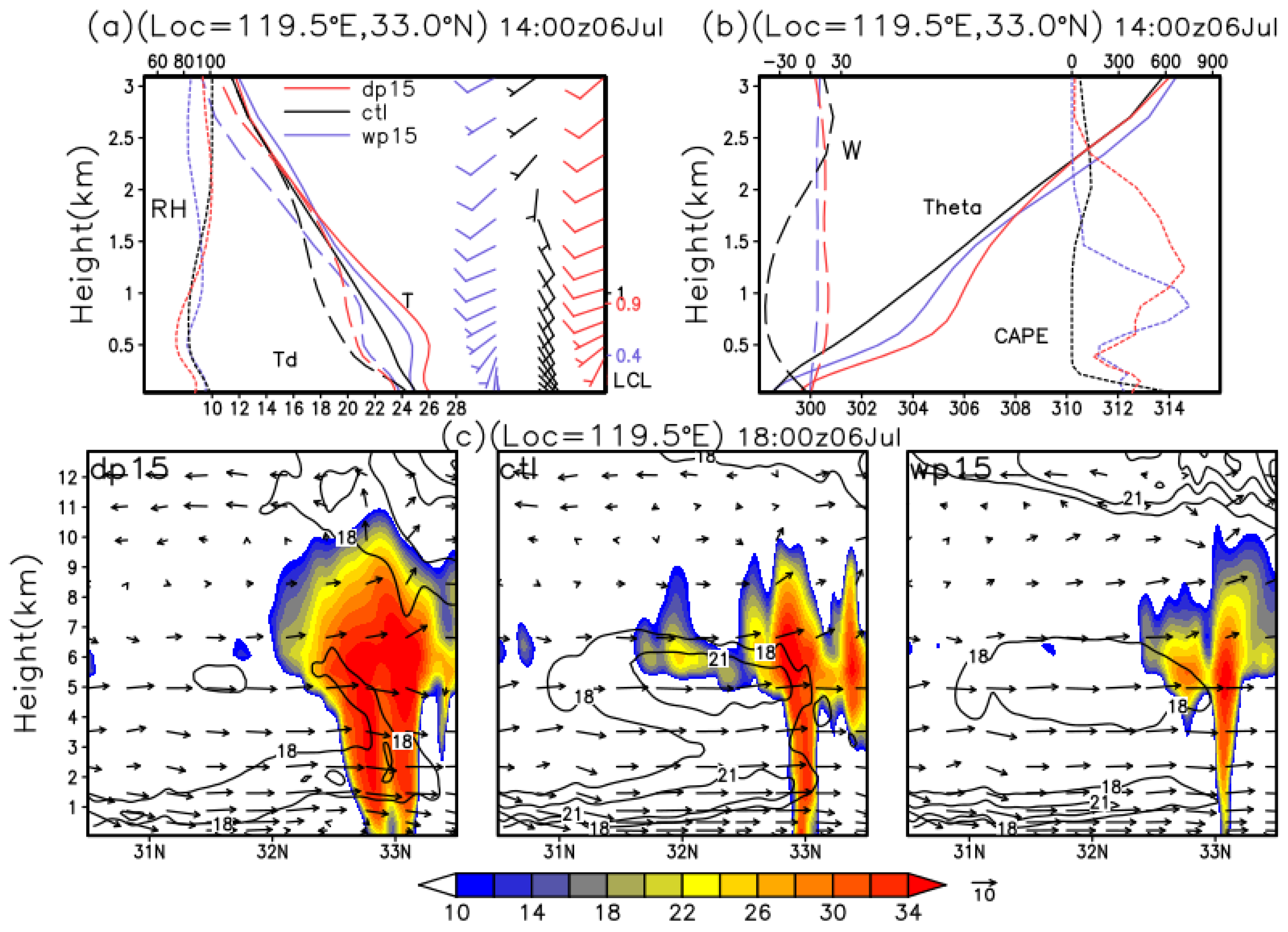
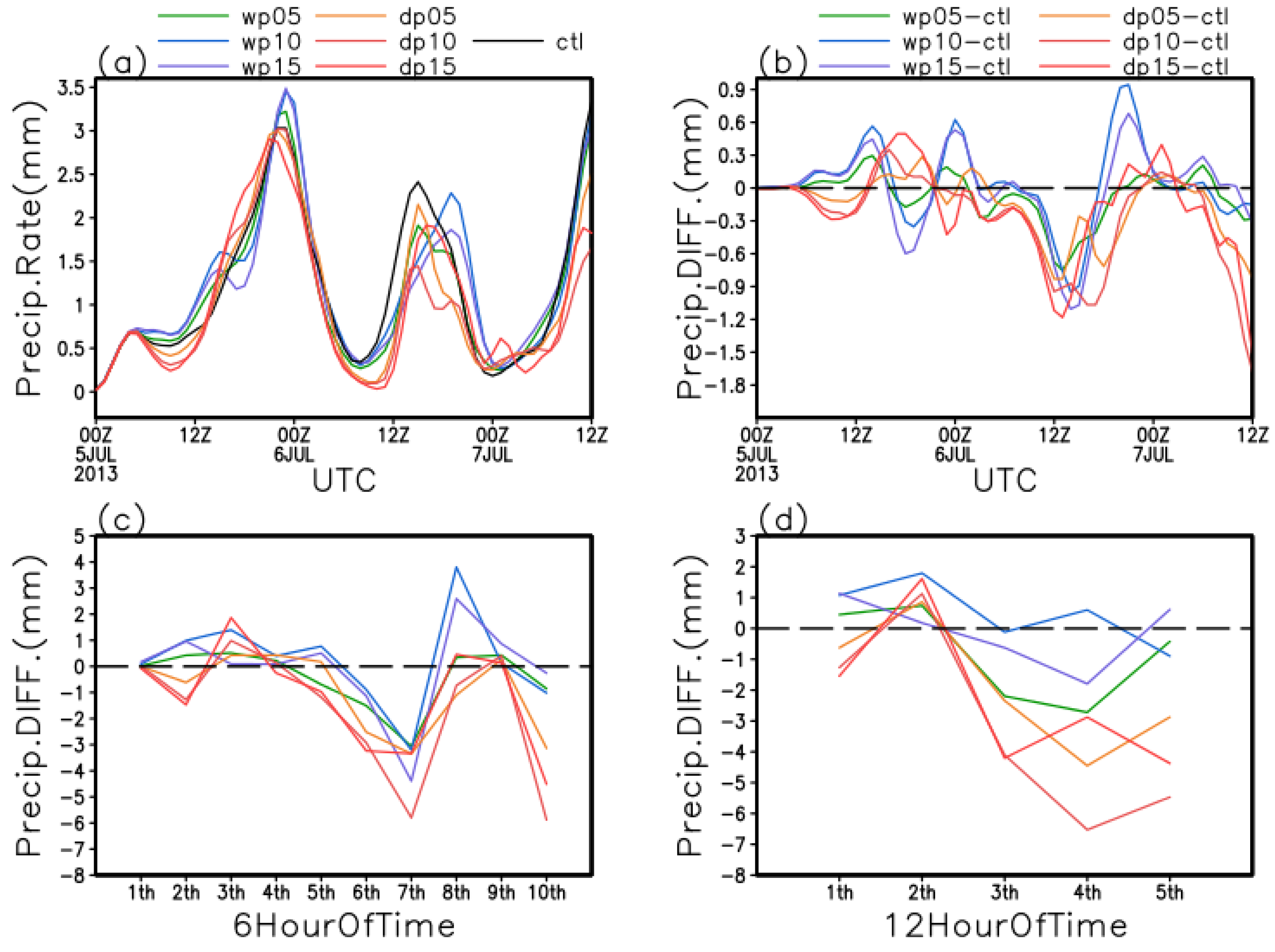
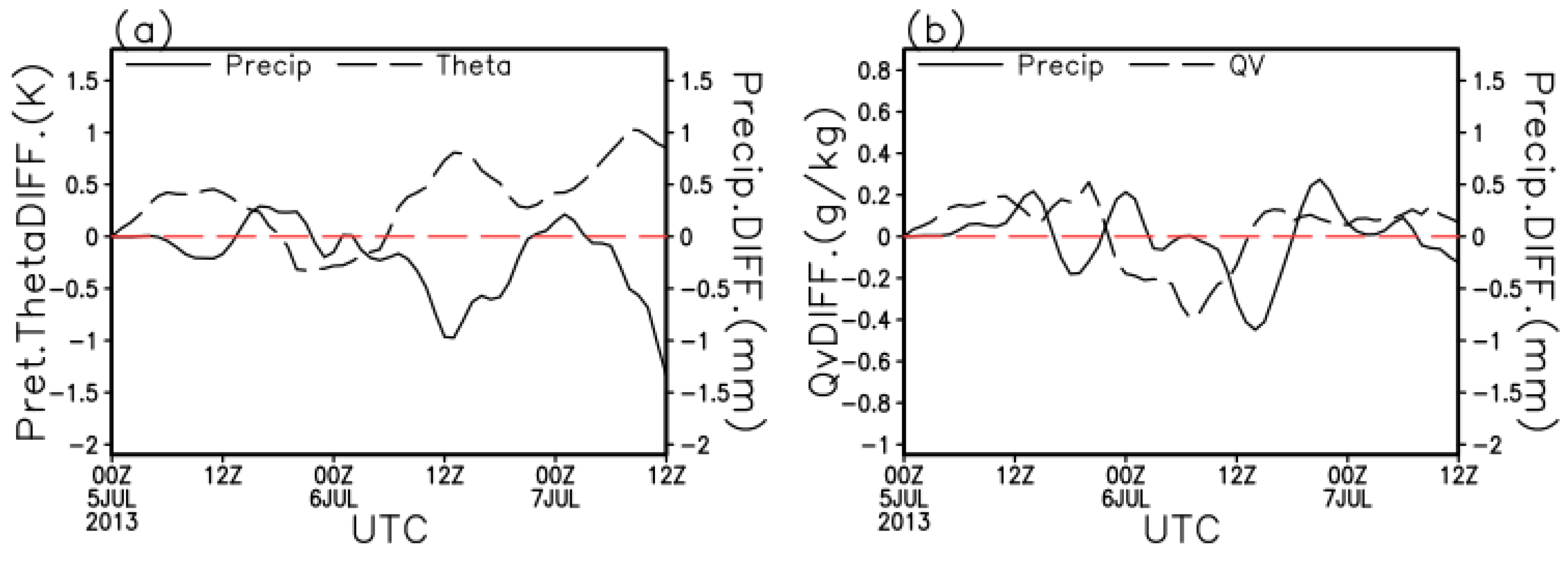
| Simulation | Soil Moisture | Atmospheric Data | Comments |
|---|---|---|---|
| FNL | FNL, 10, 30, 60, 100 cm depths | FNL, 28 vertical layers | Gridded at 100 km |
| ERA | ERA-Interim, 7, 21, 72, 155 cm depths | ERA-Interim, 38 vertical layers | Gridded at 70 km |
| Merged | GLDAS, 10, 30, 60, 100 cm depths | ERA-Interim, 38 vertical layers | Gridded at 70 km except 25 km of soil moisture |
| DPs | Merged, systemically decreased by 5%, 10% and 15% | Merged | Dry soil ensemble |
| WPs | Merged, systemically increased by 5%, 10% and 15% | Merged | Wet soil ensemble |
| Thresholds | TS | ETS | BIAS |
|---|---|---|---|
| 50 | 3.98 | 2.11 | −0.12 |
| 90 | 6.61 | 7.74 | −0.01 |
| 120 | 6.49 | 8.65 | 0.23 |
| 150 | 7.66 | 8.72 | 0.1 |
| 180 | 7.06 | 6.73 | −0.07 |
| 210 | 4.23 | 3.39 | −0.24 |
| 240 | 4.06 | 4.21 | −0.27 |
© 2016 by the authors; licensee MDPI, Basel, Switzerland. This article is an open access article distributed under the terms and conditions of the Creative Commons by Attribution (CC-BY) license (http://creativecommons.org/licenses/by/4.0/).
Share and Cite
Min, J.; Guo, Y.; Wang, G. Impacts of Soil Moisture on Typical Frontal Rainstorm in Yangtze River Basin. Atmosphere 2016, 7, 42. https://doi.org/10.3390/atmos7030042
Min J, Guo Y, Wang G. Impacts of Soil Moisture on Typical Frontal Rainstorm in Yangtze River Basin. Atmosphere. 2016; 7(3):42. https://doi.org/10.3390/atmos7030042
Chicago/Turabian StyleMin, Jinzhong, Yakai Guo, and Guojie Wang. 2016. "Impacts of Soil Moisture on Typical Frontal Rainstorm in Yangtze River Basin" Atmosphere 7, no. 3: 42. https://doi.org/10.3390/atmos7030042
APA StyleMin, J., Guo, Y., & Wang, G. (2016). Impacts of Soil Moisture on Typical Frontal Rainstorm in Yangtze River Basin. Atmosphere, 7(3), 42. https://doi.org/10.3390/atmos7030042






